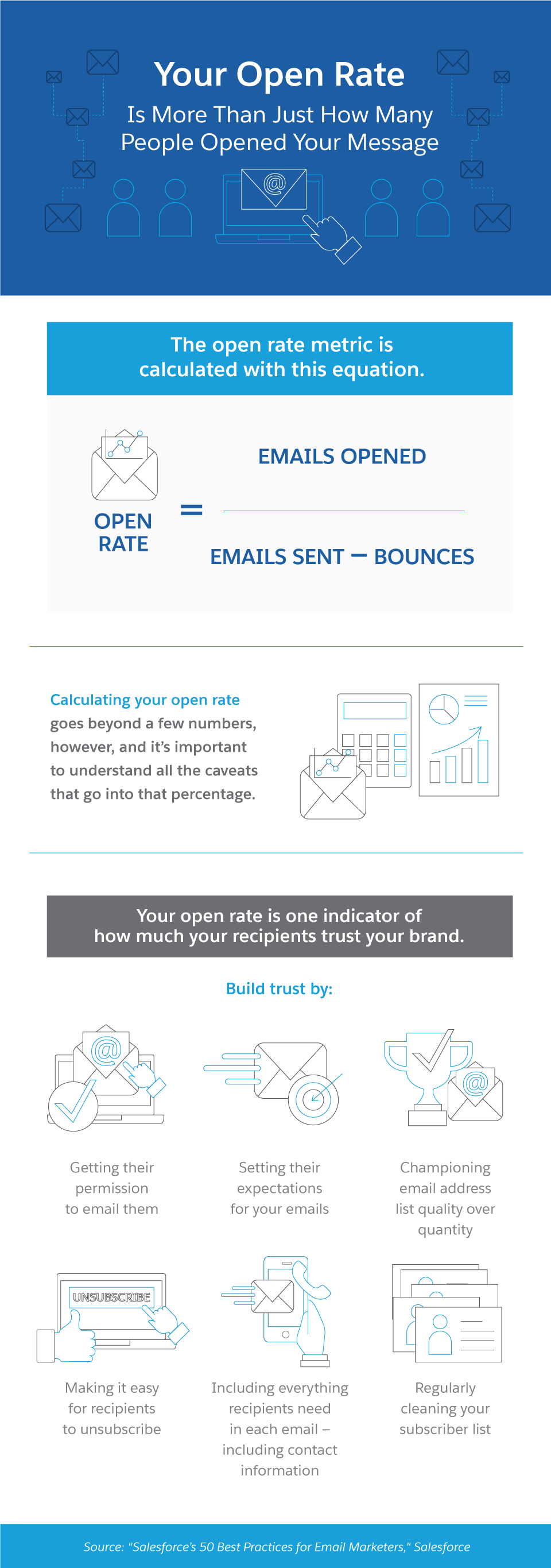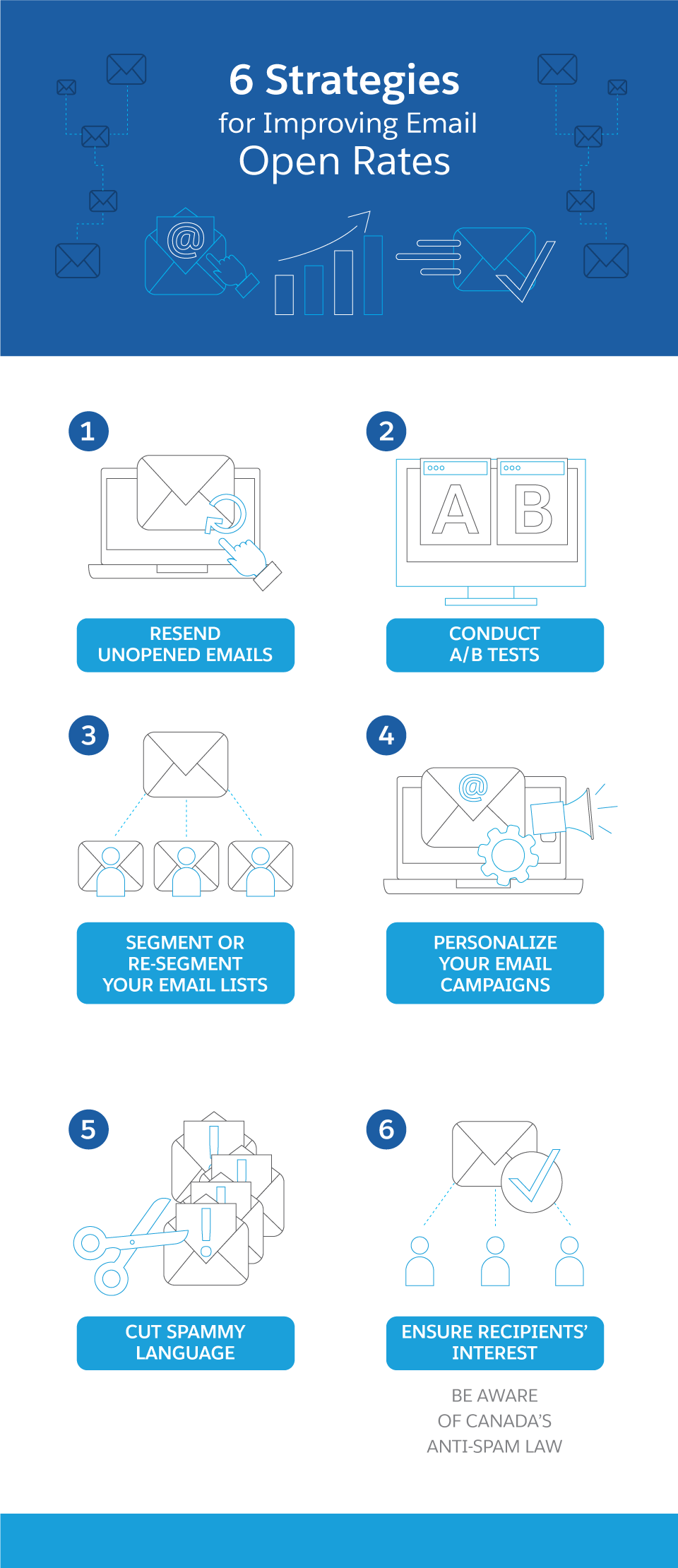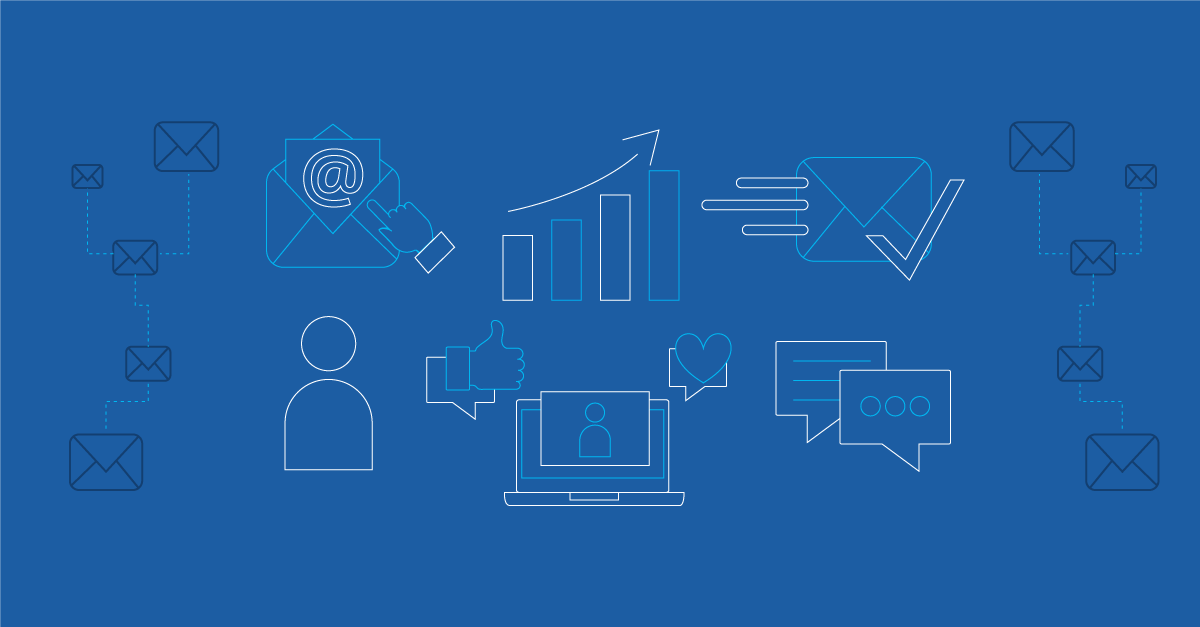By Kathryn Casna
The term “open rate” may seem self-explanatory, but understanding this metric is critical to the success of your email marketing efforts. And while calculating your open rate may be simple, improving your score isn’t because a lot of factors affect your numbers. And then there’s the question of what open rate you should shoot for anyway.
Here’s what you need to know to boost your email marketing open rates in your very next campaign.
What Is an Email Open Rate?
An email open rate is a measurement of how many people open an email. It’s calculated by dividing the number of opens by the number of successful sends (sends minus any bounces). That equation looks like this:
Emails opened
Open Rate =
Emails sent - bounces
Most email marketing tools track and calculate an email’s open rate automatically. Whether you’ve sent one or 1,000 emails, you can usually check your open rates with a few clicks.
At this point, business owners may still have questions. What counts as an open? What’s a good open rate? How do you improve your open rates?
Let’s dive into each.
Your open rate is more than just how many people opened your message
The open rate metric is calculated with this equation
Open rate = Emails opened/ emails sent-bounces
- Calculating your open rate goes beyond a few numbers, however, and it's important to understand all the caveats that go into that percentage.
- Your open rate is one indicator of how much your recipients trust your brand.
- Build trust by
- Gettin their permission to email them
- Setting their expectations for your emails
- Championing email adress list quality over quantity
- Making it easy for recipients to unsuscribe
- Including everything recipients need in each email including contact information
- Regularly cleaning your suscriber list

What Counts as an Open in Email Marketing?
To understand this metric, it helps to know its limitations. While the definition may seem pretty obvious, what you would consider an open may not be recorded that way by your email marketing tool. To track an open, email marketing tools use tracking pixels, which are considered images, and one is in every message you send to every recipient. When your customer clicks on that email, this pixel reports back to you. Unfortunately, this process doesn’t always go as planned. Some people choose to read your email without displaying images — therefore, your tracking pixel doesn’t work. Other recipients may use email clients that aren’t capable of displaying HTML. As a result, your open rates may skew lower than reality. On the flipside, many email clients offer a preview pane feature that allows users to see a portion of your email without actually clicking in. These previews may be recorded as opens, inaccurately boosting your open rates, and so might clicks that result from forwarded messages. Despite the possibility of both false positives and false negatives, tracking open rates remains critical for understanding your email marketing ROI. Currently, for every $1 spent on email marketing, companies see a return of about $42. Because open rates aren’t always accurate, you may learn more from looking at trends over time than a single email’s stats.
What’s a Good Open Rate for Email Marketing?
With the above caveats in mind, what open rate should you shoot for with your campaigns? The short answer is that it depends. The average sits around 20 per cent, but that statistic varies between industries. It’s also going to vary by the type of emails you’re sending: newsletters, promotional, drip, and others. If your open rates are lower, don’t worry. Businesses like yours are using specific strategies to boost their rates. On the other hand, if your emails consistently meet or exceed a 20 per cent open rate, you can still improve it with a few tweaks to what you’re already doing.
How Do I Improve My Email Open Rates?
Email marketing is the third-most used organic content distribution channel, but it’s only effective if people open your emails. Here’s how to increase the odds that they will.
6 strategies for Improving Email Open rates
- Resend unopened emails
- Conduct A/B tests
- Segment or re-segment your email lists
- Personalize your email campaigns
- Cut spammy language
- Ensure recipients's interest
- Be aware of Canada's anti spam law

Resend Unopened Emails
Many marketers find that simply trying again can boost the number of recipients who open a particular email. You have to be careful with this strategy, however. Resend emails only to those who haven’t opened them, or you spam those who have already read the message. If you decide to resend, consider altering your subject line or content slightly. That way, if you accidentally resend to someone who’s already seen the email (since your open rate may include false negatives), the email will look like a reminder.
Conduct More Tests
If you want higher open rates, the most efficient strategy is to find out what may be hindering your campaigns — don’t immediately revamp your entire process or give up on email altogether. Around 85 per cent of B2B organizations use email marketing software, and this channel is worth the time and effort it takes to excel. Potential changes you can try and track to see what you could improve include: Subject lines Time and day you hit send Frequency of emails Which topics get the most opens How you segment your audience Various elements of email content Keep in mind that systematic testing can be as detailed or streamlined as you choose. You gain the most insights from A/B testing, or changing a single factor at a time: Don’t change multiple variables all at once, or you’ll lose track of which changes are most effective.
Segment or Re-segment Your Lists
You have more than one type of customer or audience on your email subscriber list. For example, there’s the person who just discovered your brand; the ready-to-buy customer who’s narrowing in on a decision; and the customer who can’t wait to tell their friends about your products or services. Businesses can and should segment their email list by the stage a customer is in. Doing so prevents you from sending loyalty emails to people who haven’t bought from you yet or first-time customer discounts to repeat customers. There are other ways to segment your audience, too, including the following strategies: Which products they’re interested in How they interact with your content Geographic location Demographics, such as age, gender, and income Industry and job function (for B2B) Past purchase history Whether they’ve shopped in person or online Start with the segmentation strategy that’s most relevant to your business and continue dividing from there. You’ll create and send different content to each segment, so segment only as much as your resources allow.
Personalize Your Emails
Adding “Dear [Recipient],” to your emails is a solid step toward personalization, but it’s not enough. To achieve the level of personalization that will impress and engage your subscribers, you need two tools: segmentation (see above) and artificial intelligence (AI). With an AI tool, you can track each person’s behaviour when they interact with your brand. AI analyzes the individual’s interests and begins putting together a profile that may include demographics, progress through the sales funnel, and other factors. You can study this information to decide what kind of content to create and tailor-make sales funnels for your customers. The more relevant and interesting content you land in a person’s inbox, the more likely you are to see your open rates increase.
Cut Spammy Language
While email marketers use AI to improve open rates, email clients use machine learning, a type of AI, to weed out spam. Google, Yahoo, and others automatically flag emails and file them in the spam folder. You may be able to avoid the spam graveyard by removing certain words from your email vocabulary. Those words include the following (and many others): Action Bargain Bonus Buy Call Cash Cheap Deal Earn Freedom Great Income Legal Lifetime Now Quote Sample Satisfaction Trial Urgent Weight Some of these words may be unavoidable for your business, so try to minimize those you can’t avoid. The more spam words you nix, the less likely your emails will be flagged as spam. If you want to sidestep the dangers of spam filters even more, however, make sure your subscribers genuinely want your emails.
Ensure Customer Interest
One of the most critical ways to improve email open rates is to ensure your audience wants your messages. Legally, you must get consent from recipients to send them emails of any kind. Among other requirements, Canada's Anti-Spam Law (CASL) states that businesses must have either express or implied consent for email communications.
A few quick facts about Canada's Anti-Spam law (CASL)
CASL applies to everyone who sends electronic messages for commercial purposes
- Individuals
- Incorporated companies
- Unincorporated businesses
- Not for profit organizations
Under CASL, commercial electronic messages (CEMs) can include:
- Emails
- Sms
- Instant messages
- Messages sent through social networks
CASL defines a CEM as a message that encourages participation in a commercial activity. This incluides:
- Advertisements
- Information about promotions
- Offers
- Business opportunities
- Events
Consent is required before sending a CEM. Under CASL, you must be able to prove you have consent:
Express consent: Someone actively gave you permission to send them a CEM. To get express consent,you must:
- Clearly describe the purposes for requesting consent
- Provide the name of the person seeking consent and identify on whose behalf consent is sought, if different.
- Provide contact information (mailing adress and either a phone number or an email adress) if those parties seeking consent
- Indicate the recipient can unsuscribe
- Implied consent: It would be reasonable to conclude you have someone's permission to send them a CEM based on prior relationships.
- Anyone in the world who sends CEMs to or within Canada must research and understand CASL

Share "Know Your Metric - Email Marketing Open Rates " On Your Site
| <p><strong>Click To Enlarge</strong><br /><br /> <a href="https://www.salesforce.com/ca/blog/2020/09/know-your-metric--email-marketing-open-rates.html" _rte_href="https://www.salesforce.com/ca/blog/2020/09/know-your-metric--email-marketing-open-rates.html" target="_blank"> <img src="https://www.salesforce.com/content/dam/blogs/ca/Blog%20Posts/know-your-metric-email-marketing-open-rates-embed.png" _rte_src="https://www.salesforce.com/content/dam/blogs/ca/Blog%20Posts/know-your-metric-email-marketing-open-rates-embed.png" alt="Know Your Metric - Email Marketing Open Rates " width="600px" border="0" /> </a> </p> <p>Via <a href="https://www.salesforce.com/ca/blog/" _rte_href="https://www.salesforce.com/ca/blog/" target="_blank">Salesforce</a> </p> |
Via Salesforce



